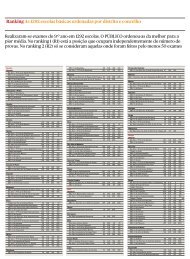Food marketing to children and youth
Food marketing to children and youth
Food marketing to children and youth
Create successful ePaper yourself
Turn your PDF publications into a flip-book with our unique Google optimized e-Paper software.
<strong>Food</strong> Marketing <strong>to</strong> Children <strong>and</strong> Youth: Threat or Opportunity?http://books.nap.edu/catalog/11514.htmlxivPREFACEYouth: Threat or Opportunity? The report represents the most comprehensivereview <strong>to</strong> date of the scientific studies designed <strong>to</strong> assess the influenceof <strong>marketing</strong> on the nutritional beliefs, choices, practices, <strong>and</strong> outcomes for<strong>children</strong> <strong>and</strong> <strong>youth</strong>. In conducting our study, the committee not only developed<strong>and</strong> applied a rigorous analytic framework <strong>to</strong> the assessment of therelevant scientific literature but also under<strong>to</strong>ok an extensive review of thenutritional status <strong>and</strong> trends for <strong>children</strong> <strong>and</strong> <strong>youth</strong>, what is known aboutthe full range of fac<strong>to</strong>rs that influence their dietary patterns, the broad <strong>and</strong>evolving food <strong>and</strong> beverage <strong>marketing</strong> environment, <strong>and</strong> the relevant policylevers that might be brought <strong>to</strong> bear <strong>to</strong> improve our <strong>children</strong>’s nutritionalstatus. Important <strong>and</strong> relevant findings from our committee’s review aredistributed throughout the body of the text. A summary list of the findingsis provided in the final chapter, along with the committee’s overall conclusions<strong>and</strong> recommendations.This report notes that the prevailing pattern of food <strong>and</strong> beverageproducts marketed <strong>to</strong> <strong>children</strong> <strong>and</strong> <strong>youth</strong> has been high in <strong>to</strong>tal calories,sugar, salt, fat, <strong>and</strong> low in nutrients. A dietary profile that mirrors theproducts marketed would put our <strong>children</strong> <strong>and</strong> <strong>youth</strong> at risk for the types ofnutritional problems that we see occurring <strong>to</strong>day—increasing rates of obesity,<strong>and</strong> inadequacies of certain important micronutrients—<strong>and</strong> for thedevelopment of various serious chronic diseases later in life. Dietary choicesare made in the midst of myriad social, cultural, <strong>and</strong> economic environmentalinfluences. The focus of the committee was on the role of food <strong>and</strong>beverage <strong>marketing</strong> as one of these intersecting influences.In our review, the committee faced certain challenges related <strong>to</strong> thenature of the available research material. First, virtually all of the publishedscientific research has focused on advertising—<strong>and</strong> television advertising inparticular. While television maintains an important place in food <strong>and</strong> beverage<strong>marketing</strong>, industry strategies have moved far beyond television advertising.Second, much of the research underpinning the development <strong>and</strong>implementation of food <strong>and</strong> beverage <strong>marketing</strong> activities is proprietary<strong>and</strong> unpublished, <strong>and</strong>, given the National Academies’ requirement thatinformation used be in the public domain, a large amount of <strong>marketing</strong>research was unavailable for the committee’s use.Nonetheless, ample information <strong>and</strong> studies were available for the committee<strong>to</strong> draw certain key conclusions, including that television advertisinginfluences the food preferences, purchase requests, <strong>and</strong> diets, at least of<strong>children</strong> under the age of 12 years, <strong>and</strong> is associated with the increasedrates of obesity among <strong>children</strong> <strong>and</strong> <strong>youth</strong>. The committee could not statethe relationship in quantitative terms, but it is clear that even a small effectacross the entire population would represent an important impact. Althoughwe could not draw conclusions about the impact of the broader<strong>marketing</strong> environment, it is highly likely that the influences reinforce thoseCopyright © National Academy of Sciences. All rights reserved.This executive summary plus thous<strong>and</strong>s more available at http://www.nap.edu
















